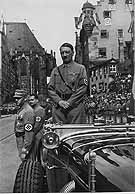
|
|
|

|

|

|

|
|
Click on an image to see a larger, more detailed picture.
|
|
|
|
|
| 1934: Triumph of the Will |

|
pg. 73 |

|
|
|
|
| |
|
|
|
|
|
|
| |
Thousands
of Nazi supporters flocked to Nuremburg in September 1934 for the city's annual weeklong celebration of Nazi solidarity. Among the sights and sounds of various parades and rallies: enormous Nazi banners that reached halfway to the heavens, 130 searchlights that beamed 25,000 feet into the night sky, and a gathering of tens of thousands of brown-shirted Storm Troopers. Bands blared "The Badenweiler March," while delirious Nazi supporters waved swastika flags and punctuated the air with cries of "Heil Hitler!" An impassioned Adolf Hitler spoke of the Party's solidarity and strength, proclaiming, "There will be no other revolution in Germany for the next 1000 years!" Filmmaker Leni Riefenstahl captured the pageantry and drama of the Nuremberg rally, creating a propaganda documentary that would be entitled Triumph of the Will. Nuremberg had hosted Nazi rallies annually since 1927, but never before had spirits been so high. Just weeks earlier, Hitler had been elected Führer of the German state in a landslide vote. It was the ultimate political victory for Hitler?a true "triumph of the will." Yet, ironically, that triumph did not come easily. During the first two years of Nazi rule, Hitler had to deal not only with the formidable tasks of Gleischaltung--a term referring to a streamlined process to put all aspects of German life under Nazi control--but also with troublesome factions inside the Nazi Party itself. The Nazi Party's populist wing and especially the Storm Troopers (Sturmabteilung, or SA) thought that the Nazi revolution was incomplete and resented that it progressed so slowly. These radical Nazis believed that big business, the traditional German bureaucracy, the military, and especially Jewish life had been left too much intact. The SA posed a particularly difficult problem for Hitler. Led by Ernst Röhm, one of Hitler's close friends from the Nazi Party's earliest days, the SA originated in the summer of 1921. With membership drawn from disgruntled World War I veterans, it became the Nazi Party's private army. At the time of Hitler's appointment as chancellor in 1933, there were more than a half-million SA men. By early 1934 that number had soared to about 4.5 million, which made the SA a force much larger than Germany's post-World War I army. Though Röhm and the SA felt they were securing Nazi Germany's interests, Hitler and many other Party leaders--to say nothing of the allies Hitler needed from German industry and the military--saw Röhm and the SA as threats to stability, particularly because it was Röhm's ambition to make the SA the true army of the Third Reich
|

|

|

|

|
|

A proud Führer reviews parading Storm Troopers at the Nuremberg Party rally.
Photo: United States Holocaust Memorial Museum Photo Archive
|
|
|
|
|
| 1934: Triumph of the Will |

|
pg. 73 |

|
|
The Holocaust Chronicle
© 2009 Publications International, Ltd.
|
|
